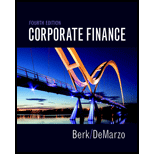
Corporate Finance Plus MyLab Finance with Pearson eText -- Access Card Package (4th Edition) (Berk, DeMarzo & Harford, The Corporate Finance Series)
4th Edition
ISBN: 9780134408897
Author: Jonathan Berk, Peter DeMarzo
Publisher: PEARSON
expand_more
expand_more
format_list_bulleted
Textbook Question
Chapter 12, Problem 8P
Suppose that in place of the S&P 500, you wanted to use a broader market portfolio of all U.S. stocks and bonds as the market proxy. Could you use the same estimate for the market risk premium when applying the
Expert Solution & Answer
Want to see the full answer?
Check out a sample textbook solution
Students have asked these similar questions
Don't used hand raiting
I need help on the last part of the question that was marked incorrect. Thanks
Don't used hand raiting
Chapter 12 Solutions
Corporate Finance Plus MyLab Finance with Pearson eText -- Access Card Package (4th Edition) (Berk, DeMarzo & Harford, The Corporate Finance Series)
Ch. 12.1 - According to the CAPM, we can determine the cost...Ch. 12.1 - What inputs do we need to estimate a firms equity...Ch. 12.2 - How do you determine the weight of a stock in the...Ch. 12.2 - Prob. 2CCCh. 12.2 - Prob. 3CCCh. 12.3 - How can you estimate a stocks beta from historical...Ch. 12.3 - How do we define a stocks alpha, and what is its...Ch. 12.4 - Why does the yield to maturity of a firms debt...Ch. 12.4 - Prob. 2CCCh. 12.5 - What data can we use to estimate the beta of a...
Ch. 12.5 - Prob. 2CCCh. 12.6 - Why might projects within the same firm have...Ch. 12.6 - Under what conditions can we evaluate a project...Ch. 12.7 - Prob. 1CCCh. 12.7 - Prob. 2CCCh. 12 - Prob. 1PCh. 12 - Suppose the market portfolio has an expected...Ch. 12 - Prob. 3PCh. 12 - Suppose all possible investment opportunities in...Ch. 12 - Using the data in Problem 4, suppose you are...Ch. 12 - Prob. 6PCh. 12 - Prob. 7PCh. 12 - Suppose that in place of the SP 500, you wanted to...Ch. 12 - Prob. 9PCh. 12 - You need to estimate the equity cost or capital...Ch. 12 - In mid-2012, Ralston Purina had AA-rated, 10-year...Ch. 12 - Prob. 15PCh. 12 - Prob. 16PCh. 12 - Prob. 17PCh. 12 - Your firm is planning to invest in an automated...Ch. 12 - Consider the setting of Problem 18. You decided to...Ch. 12 - Prob. 20PCh. 12 - In mid-2015, Cisco Systems had a market...Ch. 12 - Weston Enterprises is an all-equity firm with two...Ch. 12 - Prob. 24PCh. 12 - Your company operates a steel plant. On average,...Ch. 12 - Prob. 26PCh. 12 - You would like to estimate the weighted average...
Knowledge Booster
Learn more about
Need a deep-dive on the concept behind this application? Look no further. Learn more about this topic, finance and related others by exploring similar questions and additional content below.Similar questions
- Answer in step by step with explanation. Don't use Ai and chatgpt.arrow_forwardArticle: Current Bank Problem Statement The general problem to be surveyed is that leaders lack an understanding of how to address job demands, resulting in an increase in voluntary termination, counterproductive workplace outcomes, and a loss of customers. Bank leaders discovered from customer surveys that customers are closing accounts because their rates are not competitive with area credit unions. Job demands such as a heavy workload interfered with employee performance, leading to decreased job performance. Healthcare employees who felt the organization’s benefits were not competitive were more likely to quit without notice, resulting in retention issues for the organization. Information technology leaders who provide job resources to offset job demand have seen an increase in (a) new accounts, (b) employee productivity, (c) positive workplace culture, and (d) employee retention. The specific problem to be addressed is that IT technology leaders in the information technology…arrow_forwardHow to rewrite the problem statement, correcting the identified errors of the Business Problem Information and the current Bank Problem Statement (for the discussion: Evaluating a Problem Statement)arrow_forward
- Don't used hand raiting and don't used Ai solutionarrow_forward3 years ago, you invested $9,200. In 3 years, you expect to have $14,167. If you expect to earn the same annual return after 3 years from today as the annual return implied from the past and expected values given in the problem, then in how many years from today do you expect to have $28,798?arrow_forwardPlease Don't use Ai solutionarrow_forward
- Ends Feb 2 Discuss and explain in detail the "Purpose of Financial Analysis" as well as the two main way we use Financial Ratios to do this.arrow_forwardWhat is the key arguments of the supporters of the EITC? Explain.arrow_forwardWhat is the requirements to be eligible to receive the EITC? Explain.arrow_forward
arrow_back_ios
SEE MORE QUESTIONS
arrow_forward_ios
Recommended textbooks for you
 Intermediate Financial Management (MindTap Course...FinanceISBN:9781337395083Author:Eugene F. Brigham, Phillip R. DavesPublisher:Cengage Learning
Intermediate Financial Management (MindTap Course...FinanceISBN:9781337395083Author:Eugene F. Brigham, Phillip R. DavesPublisher:Cengage Learning
 EBK CONTEMPORARY FINANCIAL MANAGEMENTFinanceISBN:9781337514835Author:MOYERPublisher:CENGAGE LEARNING - CONSIGNMENT
EBK CONTEMPORARY FINANCIAL MANAGEMENTFinanceISBN:9781337514835Author:MOYERPublisher:CENGAGE LEARNING - CONSIGNMENT

Intermediate Financial Management (MindTap Course...
Finance
ISBN:9781337395083
Author:Eugene F. Brigham, Phillip R. Daves
Publisher:Cengage Learning


EBK CONTEMPORARY FINANCIAL MANAGEMENT
Finance
ISBN:9781337514835
Author:MOYER
Publisher:CENGAGE LEARNING - CONSIGNMENT
Chapter 8 Risk and Return; Author: Michael Nugent;https://www.youtube.com/watch?v=7n0ciQ54VAI;License: Standard Youtube License